Ernest Hemingway was born in 1899 in Oak Park, Illinois US. He started working for a newspaper at the age of 17 and served in a volunteer ambulance unit during World War I. He was wounded and decorated by Italy during this period. Later on, he Joined American expatriates in Paris and wrote about his experiences in The Sun Also Rises. Many of his works gained world wide fame but The Old Man and Sea was his most famous Noble Prize winning work. He liked sportsmen and wrote about hunters, bull fighters, soldiers and the primitive people whom he liked for their courage and faith. Hemingway’s straightforward writing style has influenced many writers of fiction and short stories. Hemingway’s work is particularly noted for its style about which Zoe Trodd wrote that Hemingway’s Iceberg Theory, ‘demanded that the reader feel the whole story…and fill the gaps left by his omissions with their feelings’.
1. The old Man and the Sea
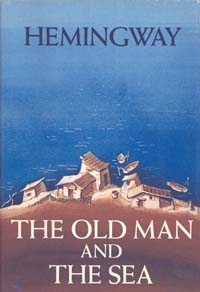
The Old Man and the Sea is the most famous novel of Ernest Hemingway. Published in 1952, it was awarded the Pulitzer Pride for fiction in 1953, and the Nobel Prize in Literature in 1954. The story is about Santiago- an old fisherman who ran out of luck and could not catch any fish for 84 consecutive days. He was all alone and even the boy whom he taught fishing, left him to work with others, under the instructions of his parents. On the 84th day he set his lines, and by noon a big fish, which he believed was a marlin took his bait and instead of being pulled started dragging his skiff. The duel between Santiago and the marlin continued for two days and two nights. His hands and body were wounded due to the friction of the fishing lines he tried to pull. When he was rowing towards his home, small fish attacked and consumed the big fish, leaving the skeleton alone by the time he reached his destination.
2. A Farewell to Arms
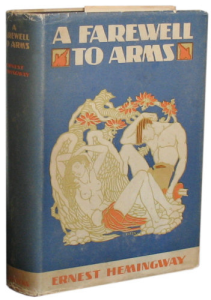
The novel, A Farewell to Arms was written by Ernest Hemingway and published for the first time in 1929. It is a semi autobiographical account of the events that took place in the First World War. The story is about Frederic Henry, an American lieutenant serving in the ambulance corps of the Italian Army, and a nurse named Catherine Barkley. The novel is made up of five books. In the first book Rinaldi introduces Henry to Catherine. The second book is about the development of their relationship. Third book is about the return of Henry to his unit. The fourth book is about their reunion , and fleeing to Switzerland in a row boat. In the last book, they live an isolated life in a mountain where Catherine dies after giving birth to a still born son.
3. For whom the Bell Tolls
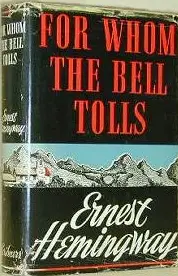
For whom the Bell Tolls is a novel written by Ernest Hemingway, published in 1940 for the first time. Its story is about a young American of International Brigades attached with the Republican Guerrillas Unit during the Spanish civil war. He is assigned to blow a bridge with dynamite during a planned attack on the city of Segovia. Pablo, the guerrilla leader is unwilling to conduct the operation fearing that that it would be dangerous for their lives, but Jordan is committed to his mission and detonates the dynamite successfully. He is shot and wounded in the end, and he bades farewell to Maria, asking her to escape. A companion fighter offers to shoot him to get rid of pain which he refused hoping that he might kill an officer of army before dying. The novel exposes the brutality of the war.
4. To have and Have Not

To Have and Have Not is the only novel which Hemingway set in the United States from 1935 to 1937. The novel was published by Scribbers on October 15, 1937. Cosmopolitan magazine published a section of the novel as One Tip Across in 1934. The novel is started in the first person but fluctuates between the first and third person quite frequently. The story is about a fishing boat captain, Harry Morgan who is deceived by the fishing charter customer Mr. Johnson, who flees away to mainland without making his payment. Morgan, under economic constraints, decides to smuggle Chinese Immigrants into Florida but he kills the person in charge of the operation on account of a monetary dispute. Morgan is killed in the end by revolutionaries. ‘To Have and Have Not’ reflects the Great Depression which caused deprivation and hunger in the residents of Key West.
5. The Sun also Rises
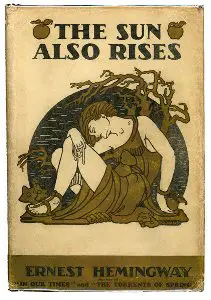
The Sun also Rises is a novel by Hemingway, which according to his biographer Jeffery Meyers, is ‘recognized as Hemingway’s greatest work.’ Linda Wagner-Martin- the well known Hemingway Scholar calls The Sun also Rises his most important novel. It was published in 1926 by the publishing house Scribber’s. The novel is about a group of American and British Expatriates who leave Paris to see the festival of San Ferminin and to see the running bulls (and bull fights). The writing was prompted by an earlier visit of Hemingway to Spain. It is considered a representative example of the Iceberg Theory. At the tip of the iceberg is the story of the protagonist Jake Barnes, whom a war wound made impotent. He had an affair with a divorcee, Lady Brett Ashley; her relationship with Cohn upsets Jake.
6. The Torrents of spring
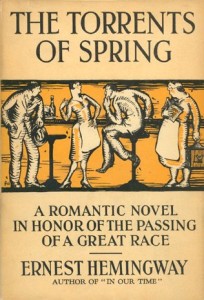
The Torrents of Spring was written by Ernest Hemingway as a parody of Sherwood Anderson’s Dark Laughter. It was published in 1926.The novel is bout two men-Yogi Johnson and Scripps O’ Neil. Both work at a pump factory. O’ Neil returns from war and finds that his wife and daughter eft him. O’Neil befriends a waitress and asks her to marry him, but is soon turned off. He develops relationship with another waitress. Being frustrated by a Parisian prostitute, Johnson befriends the wife of an Indian at the end of the story.
7. Across the River and Into the Trees
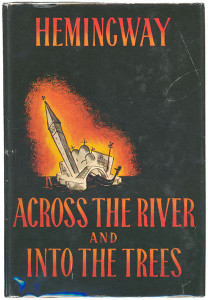
Across the River and Into the Trees, by Ernest Hemingway was first published in 1950. The story begins with 50 year old Colonel Cantwell duck hunting at Trieste. In the second chapter Hemingway shifts the setting of novel from present to past and continues for 36 chapters and reverts to the present thereafter. Cantwell, suffering from cardiac disease, spends a weekend at his Trieste hunting resort and recalls the time spent with 18 year old Renata in Venice. Cantell finally leaves Trieste, suffering from fatal heart attack.
8. Green Hills of Africa
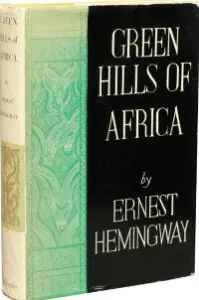
Green Hills of Africa appeared as a series in Scribber’s Magazine. It is an account of his trip with his wife Pauline Marie Pfeiffer, to Africa in 1933. The non-fiction novel was published in 1935. The book is composed of four different stories- Pursuit and Conversation, Pursuit Remembered, Pursuit and Failure, and Pursuit as Happiness. Hunting adventures in East Africa cover a major part of the book. Generally, Hemingway describes the regional landscape of Lake Manyara in Tanzania. He presents big game hunting as a non-fiction. He also describes relations between black and white hunters.
9. Islands in the Stream

Islands in the Stream was Ernest Hemingway’s first novel to be published posthumously in 1970. This work was found by Mary Hemingway after his death. The story is about an American Painter named Thomas Hudson who likes the tranquil environment of Bimini in the Bahamas, away from the city lifestyle. He is disturbed by the arrival of his three sons. In the second act Hudson is an introvert. In the final act ‘At the Sea’ Hudson chases the fleeing Germans who burned an entire village. Hudson is fatally wounded in the end.
10. The Garden of Eden

The Garden of Eden was the second novel of Ernest Hemingway which was published posthumously in 1986. It is a story about five months in the lives of an American writer’ David Bourne and his wife Catherine. The Garden of Eden is set in French Rivera and Spanish Cote d’Azur. The couple meets a young woman Marita, whom both befriend. David develops a relationship with her at the cost and deterioration of the relationship with his wife, culminating in their separation.
Conclusion:
In the Nobel Prize award ceremony speech, Permanent Secretary of the Swedish Academy spoke about Ernest Hemingway and declared that ‘his narrative skill often attains its highest point when cast in a smaller mould, in the laconic, drastically pruned short story, which with a unique combination of simplicity and precision, nails its theme into our consciousness so that every blow tells.’








Leave a Reply